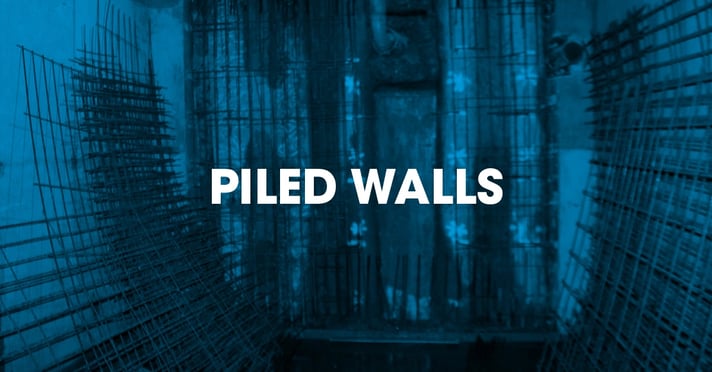Piled walls - contiguous or secant
These types of construction use a series of continuous flight auger (CFA) piles drilled and concreted in one continuous operation to form a retaining structure. On completion the ground to one side is excavated to the new reduced or lower level, exposing the face of the piling system. Piled walls in the majority of situations will be incorporated into the finished structure.
Contiguous piled walls are formed by a series of closely spaced reinforced piles complete with a reinforced capping beam to form a below ground retaining structure.
Secant piled walls are formed by a series of interlocking reinforced piles, made by introducing an additional pile which interlocks or cuts into the two adjacent piles and completed with a reinforced capping beam.
Approaches to structural waterproofing
The choice around selection of a suitable piled wall system will typically be dictated by the site requirements and will always be the subject of a specialist design from an Engineer, and largely based around the structural design parameters for the project and the characteristics of the ground associated with the site.
In relation to structural waterproofing, both contiguous and secant piled walls may contribute to limiting any expected ground water through the finished structure. However for the purpose of Warranty, they are not considered capable of achieving the required level of protection required of structural waterproofing solutions in isolation.
Resultantly any proposals must include additional structural waterproofing protection measures if they are used to construct below ground structure or basements related to usable spaces which are the subject of Warranty cover.
Dependent upon the environmental grade required for the associated below ground spaces, the design may utilise one or a combination of approaches to structural waterproofing protection against water ingress:
- Type A (Barrier) protection, which is dependent on a separate barrier system applied to the structure.
- Type B (Structurally integral) protection, which is provided by the structure.
- Type C (Drained) protection, which is provided by the incorporation of an appropriate internal water management system to avoid ingress into usable spaces.
Warranty stance
Where contiguous or secant piled wall systems are used, additional structural waterproofing protection measures must be designed by a Waterproofing Design Specialist with demonstrable experience in working with these specialist piled wall systems, and be completed alongside the Engineer responsible for the structural designs of the chosen piled wall construction technique.
The Waterproofing Design Specialist should use the guidance of ‘BS8102:2022 – Code of Practice for the protection of below ground structures against water ingress’ in selecting appropriate design strategies and approaches for this specialist wall design.
For further guidance on the requirements for Warranty in relation to structural waterproofing, reference should be made to the ‘Basements’ section of the Technical Manual.

